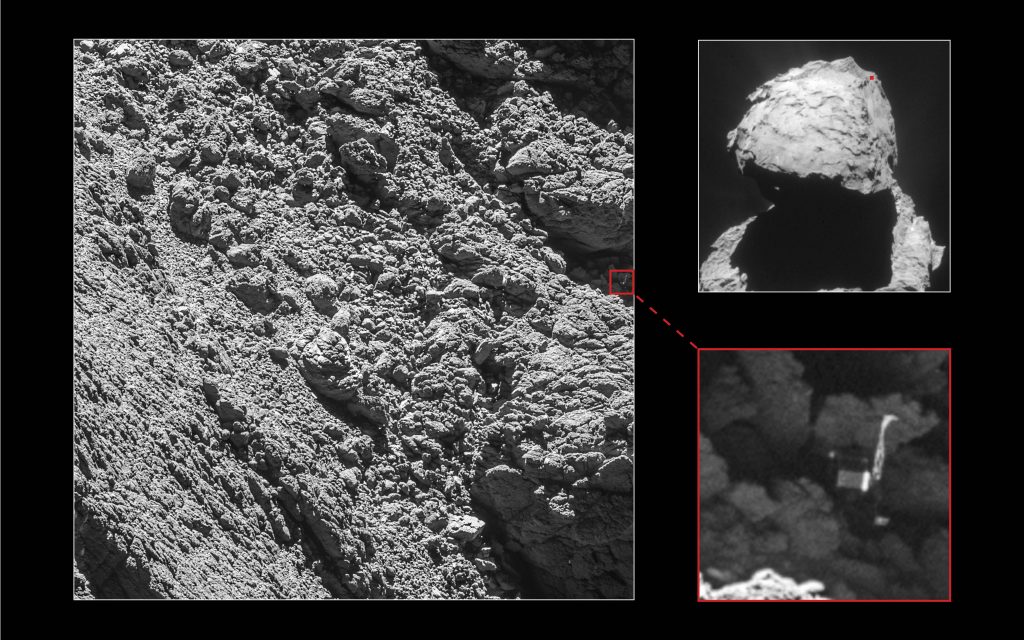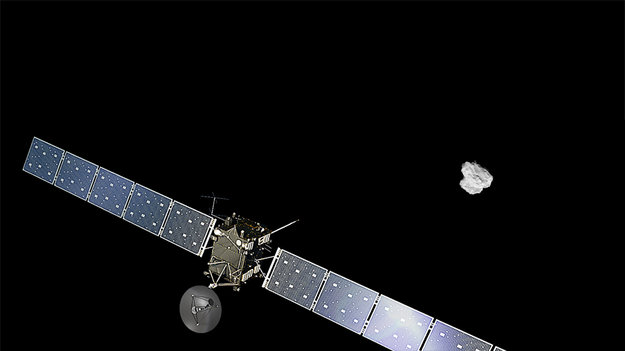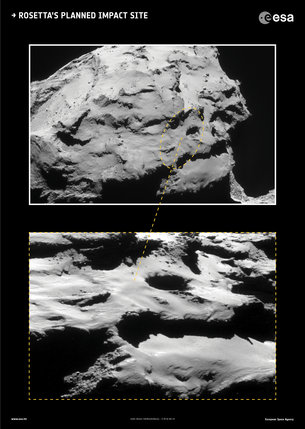.
1.09.2016
COMETWATCH – LATE AUGUST ROUND-UP
-
This week's CometWatch entry was taken with Rosetta's NAVCAM on 17 August 2016, when the spacecraft was 13.9 km from the nucleus of Comet 67P/Churyumov-Gerasimenko.

Enhanced NAVCAM image of Comet 67P/C-G taken on 17 August 2016, 13.9 km from the nucleus. The scale is 1.2 m/pixel and the image measures 1.2 km across. Credits: ESA/Rosetta/NAVCAM – CC BY-SA IGO 3.0
This close-up view shows a portion of the Imhotep region, on the large comet lobe.
The top part of the image portrays the flat, smooth-covered portion of Imhotep, scattered with a variety of boulders of different sizes. Towards the top right is a cluster of three large boulders, including the 45-m sized Cheops, named after the Great Pyramid at Giza near Cairo in Egypt.
Around the comet's perihelion, Rosetta observed many spectacular changes on this portion of Imhotep (see blog post 'Comet surface changes before Rosetta’s eyes').
To have an idea of the surface changes, you can compare the new CometWatch with a number of images of the same region taken in the past months by Rosetta: from early images such as CometWatch 26 October 2014 and the close fly-by of 14 February 2015 to more recent ones, for example this OSIRIS wide-angle camera image taken on 25 May 2016.
In the lower part of today's image, a number of circular features are visible, many of which appear to be stacked on top of one another. These roundish features can also be seen, under a different perspective, in an OSIRIS narrow-angle camera image from 16 July 2016.
A view of the Imhotep region in the overall context of Comet 67P/C-G is provided in a recent OSIRIS wide-angle camera image, taken on 10 August 2016, and you can find more details about the various geological aspects of this region in the blog post 'Inside Imhotep'.
Meanwhile, the OSIRIS team have published a number of striking new views of the comet via their image of the day website.
An OSIRIS wide-angle camera image captured less than 7 km from the comet centre on 15 August depicts portions of both lobes of 67P/C-G. The steep cliffs of the small lobe Hathor region are visible on the right, declining towards the neck, which is hidden from sight in this view by the dust-covered terrains of Ash, visible on the right.
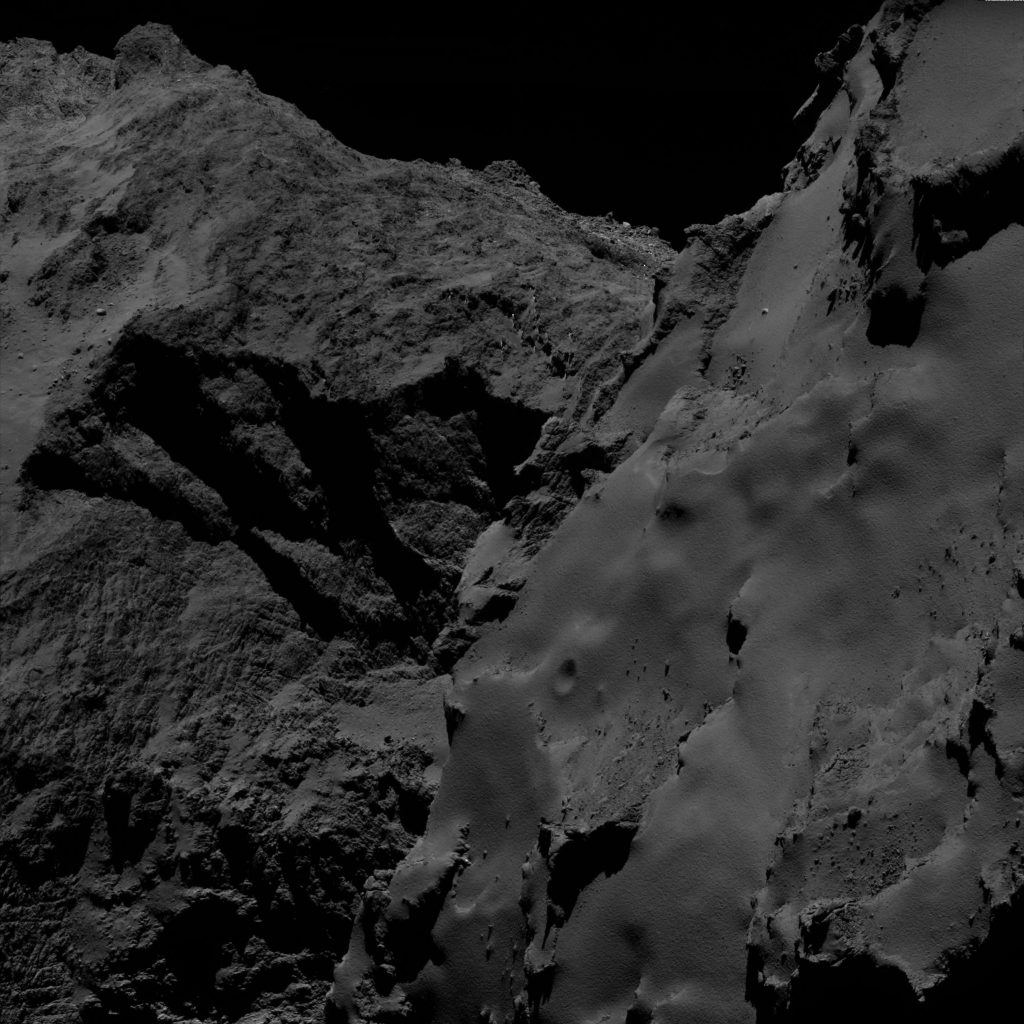
OSIRIS wide-angle camera image taken on 15 August 2016, when Rosetta was 6.8 km from Comet 67P/C-G. The scale is 0.59 m/pixel and the image measures about 1.2 km across. Credits: ESA/Rosetta/MPS for OSIRIS Team MPS/UPD/LAM/IAA/SSO/INTA/UPM/DASP/IDA
The small, roundish feature visible in the lower part of this image was described the only unambiguously identified impact crater on the comet surface in a paper by N. Thomas et al. (part of the Science special issue: Catching a Comet, 2015). About 35 m in diameter, the crater appears to have been partially buried by the smooth material that covers the Ash region.
Another image, taken with the OSIRIS narrow-angle camera about 6 km from the comet centre on 18 August, depicts in extraordinary detail some of the boulders on a different portion of the Ash region.
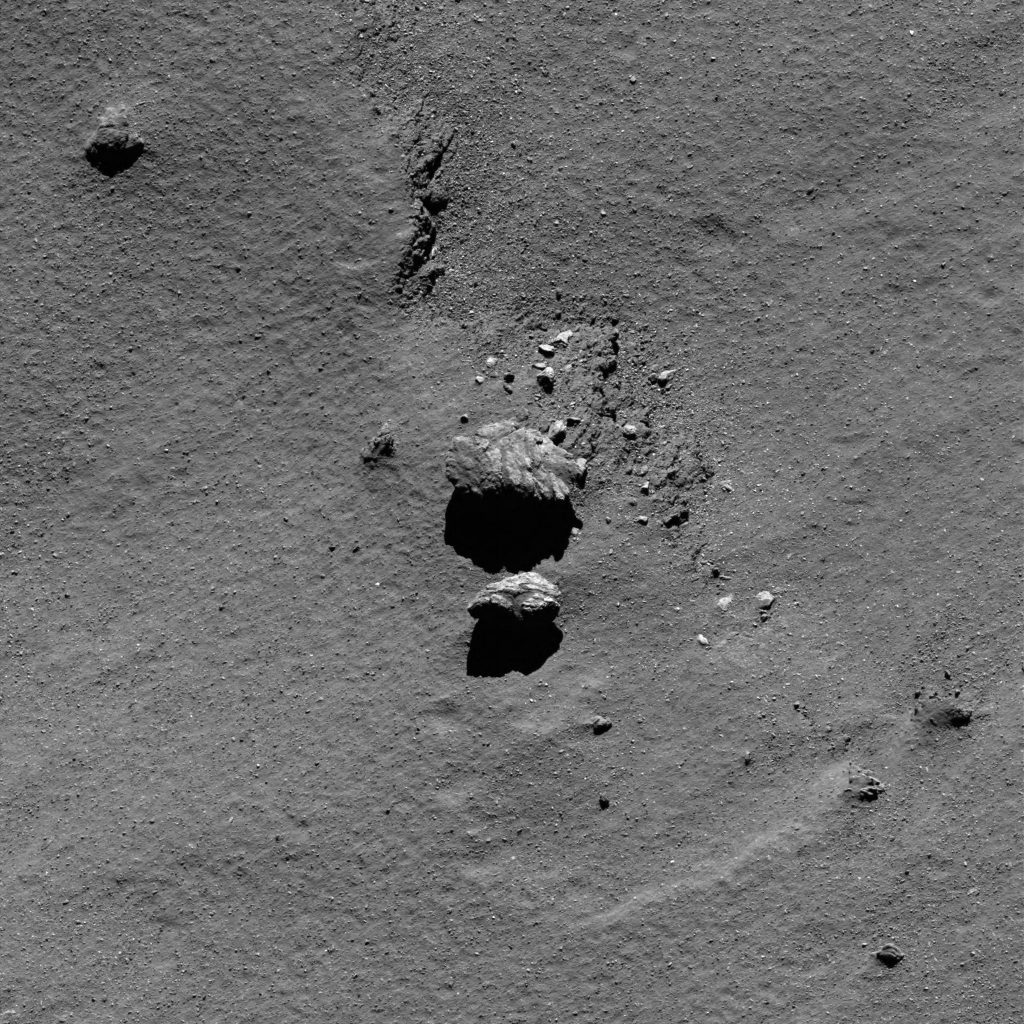
OSIRIS narrow-angle camera image taken on 25 May 2016, when Rosetta was 6.1 km from Comet 67P/C-G. The scale is 0.11 m/pixel and the image measures about 225 m across. Credits: ESA/Rosetta/MPS for OSIRIS Team MPS/UPD/LAM/IAA/SSO/INTA/UPM/DASP/IDA
You can try and find these boulders in another recent OSIRIS image (second from top in this post), which portrays Ash in a broader context – including the above mentioned crater.
Another stunningly detailed OSIRIS narrow-angle camera image, taken only a couple of days ago, on 24 August, reveals the rough texture of the Khonsu region (left and lower part of the image) next to the slopes that separate it from Atum, a portion of which is visible in the top right corner. A recent NAVCAM image taken on 8 August 2016 presents a broader view on this region.

OSIRIS narrow-angle camera image taken on 24 August 2016, when Rosetta was 9.3 km from Comet 67P/C-G. The scale is 0.16 m/pixel and the image measures about 330 m across. Credits: ESA/Rosetta/MPS for OSIRIS Team MPS/UPD/LAM/IAA/SSO/INTA/UPM/DASP/IDA
This week's original NAVCAM image is provided below.

----
IMAGING TINY COMET DUST IN 3D
Rosetta has imaged the smallest grains of Comet 67P/Churyumov-Gerasimenko’s dust yet, with its Micro-Imaging Dust Analysis System, MIDAS.
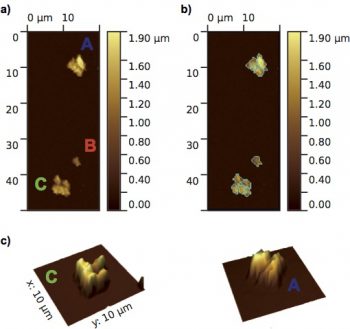
Atomic force microscope topographic images of MIDAS particles A, B, and C. (a) Overview image with a pixel resolution of 312 nm and a colour scale representing height. (b) Sub-units (grains) of the individual particles detected at the resolution of the instrument are outlined. (c) 3D images of particles A and C with two times height exaggeration to aid visualisation. Particles A and C comprise tightly packed ‘compact’ grains, while B appears to be a single grain.
MIDAS works by collecting and then physically scanning grains with an Atomic Force Microscope. This uses a very fine tip, a bit like an old-fashioned record player needle, that is scanned over a particle. The deflection of the needle and therefore the height of the sample are measured to build up a 3D picture. This enables scientists to determine the structure of the particle, and thus gain insight into how it might have formed.
The new results, published in the journal Nature, provide evidence that dust particles continue to be aggregates below the size range already reported by the COSIMA instrument. That is, even at the very small scales of a few tens of micrometres down to a few hundred nanometres, the dust grains analysed by MIDAS appear to be made up of numerous smaller grains.
“To understand how comets are formed, we need to understand the structure of the smallest grains and how they are built,” says Mark Bentley of the Space Research Institute at the Austrian Academy of Science in Graz, Austria, principal investigator of MIDAS and lead author of the paper. “What we see with MIDAS is that everything is made of smaller and smaller aggregates; it’s similar to what the COSIMA instrument sees but continued down to even smaller scales.”

Atomic force microscope topographic images of MIDAS compact particle D. (a) Overview image with a pixel resolution of 80 nm and a colour scale representing height. (b) Sub-units (grains) of the particle detected at the resolution of the instrument are outlined. (c) 3D image of the particle with two times height exaggeration to aid visualisation.
MIDAS detected both small, tightly packed ‘compact’ grains and larger more porous, loosely arranged ‘fluffy’ grains. The comet grains also appear to be elongated, several times longer in one direction than the others, in agreement with observations of dust in the interstellar medium.
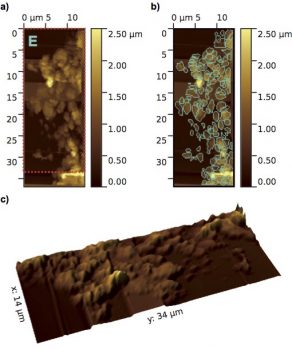
Atomic force microscope topographic images of MIDAS particle E, a loosely packed ‘fluffy’ aggregate comprising many grains. (a) Overview image with a pixel resolution of 210 nm and a colour scale representing height. b) Sub-units (grains) of the particle detected at the resolution of the instrument are outlined. (c) 3D image of the particle corresponding to the area covered by the red outline in (a) with two times height exaggeration to aid visualisation.
Examples of the different types, which were collected by MIDAS from mid-November 2014 to February 2015, are shown in the figures accompanying this post.
One particularly large, porous grain captured from Comet 67P/C-G has similar properties to a type of so-called ‘interplanetary dust grain’ (IDP) thought to have grown into porous aggregates of smaller spheroidal particles during the early phases of Solar System formation.
These new results from MIDAS further strengthen the link between IDPs and cometary dust. The observed “aggregate of aggregates” structure of the particles gives hints to their formation mechanism, and how such particles could form a weakly bound layer at the surface of the comet nucleus.
“Aggregate dust particles at comet 67P/Churyumov-Gerasimenko” by M.S. Bentley et al is published in Nature.
See our 2014 blog post "Introducing MIDAS" for background on the instrument.
All images, credit: ESA/Rosetta/IWF for the MIDAS team IWF/ESA/LATMOS/Universiteit Leiden/Universität Wien
Quelle: ESA
-
Update: 6.09.2016
.
PHILAE FOUND!
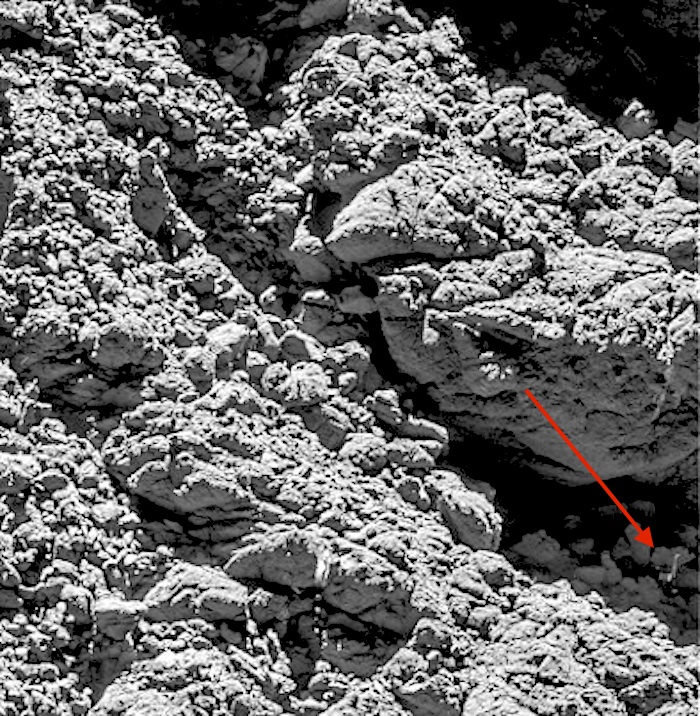
Less than a month before the end of the mission, Rosetta’s high-resolution camera has revealed the Philae lander wedged into a dark crack on Comet 67P/Churyumov–Gerasimenko.
The images were taken on 2 September by the OSIRIS narrow-angle camera as the orbiter came within 2.7 km of the surface and clearly show the main body of the lander, along with two of its three legs.
The images also provide proof of Philae’s orientation, making it clear why establishing communications was so difficult following its landing on 12 November 2014.
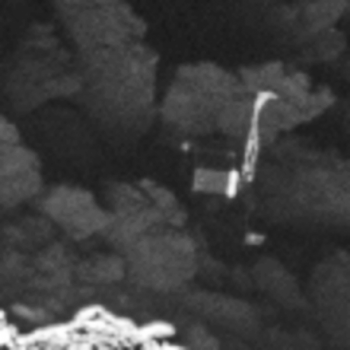
Close-up of the Philae lander, imaged by Rosetta’s OSIRIS narrow-angle camera on 2 September 2016 from a distance of 2.7 km. The image scale is about 5 cm/pixel. Philae’s 1 m-wide body and two of its three legs can be seen extended from the body. The images also provide proof of Philae’s orientation.
The image is a zoom from a wider-scene, and has been interpolated.
Credits: ESA/Rosetta/MPS for OSIRIS Team MPS/UPD/LAM/IAA/SSO/INTA/UPM/DASP/IDA
“With only a month left of the Rosetta mission, we are so happy to have finally imaged Philae, and to see it in such amazing detail,” says Cecilia Tubiana of the OSIRIS camera team, the first person to see the images when they were downlinked from Rosetta yesterday.
“After months of work, with the focus and the evidence pointing more and more to this lander candidate, I’m very excited and thrilled that we finally have this all-important picture of Philae sitting in Abydos,” says ESA’s Laurence O’Rourke, who has been coordinating the search efforts over the last months at ESA, with the OSIRIS and SONC/CNES teams.
Philae was last seen when it first touched down at Agilkia, bounced and then flew for another two hours before ending up at a location later named Abydos, on the comet’s smaller lobe.
After three days, Philae's primary battery was exhausted and the lander went into hibernation, only to wake up again and communicate briefly with Rosetta in June and July 2015 as the comet came closer to the Sun and more power was available.

An OSIRIS narrow-angle camera image taken on 2 September 2016 from a distance of 2.7 km in which Philae was definitively identified. The image has been processed to adjust the dynamic range in order to see Philae while maintaining the details of the comet’s surface. Philae is located at the far right of the image, just above centre. The image scale is about 5 cm/pixel. Credits: ESA/Rosetta/MPS for OSIRIS Team MPS/UPD/LAM/IAA/SSO/INTA/UPM/DASP/IDA
However, until today, the precise location was not known. Radio ranging data tied its location down to an area spanning a few tens of metres, but a number of potential candidate objects identified in relatively low-resolution images taken from larger distances could not be analysed in detail until recently.
While most candidates could be discarded from analysis of the imagery and other techniques, evidence continued to build towards one particular target, which is now confirmed in images taken unprecedentedly close to the surface of the comet.
At 2.7 km, the resolution of the OSIRIS narrow-angle camera is about 5 cm/pixel, sufficient to reveal characteristic features of Philae’s 1 m-sized body and its legs, as seen in these definitive pictures.
“This remarkable discovery comes at the end of a long, painstaking search,” says Patrick Martin, ESA’s Rosetta Mission Manager. “We were beginning to think that Philae would remain lost forever. It is incredible we have captured this at the final hour.”
“This wonderful news means that we now have the missing ‘ground-truth’ information needed to put Philae’s three days of science into proper context, now that we know where that ground actually is!” says Matt Taylor, ESA’s Rosetta project scientist.
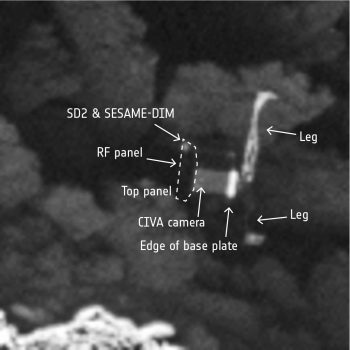
A number of Philae’s features can be made out in this image taken by Rosetta’s OSIRIS narrow-angle camera image on 2 September 2016, including one of the CIVA panoramic imaging cameras, the SD2 drill and SESAME-DIM (Surface Electric Sounding and Acoustic Monitoring Experiment Dust Impact Monitor). Credits: ESA/Rosetta/MPS for OSIRIS Team MPS/UPD/LAM/IAA/SSO/INTA/UPM/DASP/IDA
"Now that the lander search is finished we feel ready for Rosetta's landing, and look forward to capturing even closer images of Rosetta's touchdown site,” adds Holger Sierks, principal investigator of the OSIRIS camera.
The discovery comes less than a month before Rosetta descends to the comet’s surface. On 30 September, the orbiter will be sent on a final one-way mission to investigate the comet from close up, including the open pits in the Ma’at region, where it is hoped that critical observations will help to reveal secrets of the body’s interior structure.
Quelle: ESA
-
Update: 8.09.2016
.
WHAT DOES THE ROSETTA MISSION MEAN TO YOU?
To celebrate the success of Rosetta and to keep a long-lasting record of its impact on the world, we invite you to share your personal experiences and feelings about how the mission has influenced you.
Perhaps you followed the mission via this blog, the news or other social media channels, and found a special link between the spacecraft visiting Comet 67P/Churyumov–Gerasimenko and your own experience.
Maybe you've been stimulated to create art, music, or a theatrical production, or perhaps you brought Rosetta and Philae into your every day life at home through creative activities or games with your children. Or did you learn about the mission at school? Maybe you based a project on Rosetta and Philae’s adventures, or even made a further education or career choice inspired by the mission.
To get some idea of what you’ve been up to, we invite you to tell us and the world what this extraordinary mission has meant to you over the past few months/years, by contributing to the newly-opened Rosetta Legacy tumblr page.
Submissions can be in the form of text, images, video files or links (including links to audio material): anything that expresses your thoughts, feelings or personal experiences inspired by Rosetta.

Plush toy inspired by the Rosetta & Philae cartoon characters (also available on www.rosettashop.eu)
Each week, we will select up to five spot prize winners from the most recent submissions to receive a Rosetta and Philae plush toy.
We will accept submissions until 7 October 2016, but those received before 21 September will also be in with a chance to be showcased during the live programme of Rosetta’s end-of mission-event that will be streamed from ESA's European Space Operations Centre (ESOC) in Darmstadt, Germany, on 30 September.
In addition, out of all the submitted contributions, ESA will select one top prize winner who will be invited for a special visit to the European Space Research and Technology Centre (ESTEC), ESA's technical ‘heart’ located in Noordwijk, The Netherlands.
We look forward to receiving your entries and hearing all about your experience with Rosetta!
---
ROSETTA CATCHES DUSTY ORGANICS
Rosetta’s dust-analysing COSIMA (COmetary Secondary Ion Mass Analyser) instrument has made the first unambiguous detection of solid organic matter in the dust particles ejected by Comet 67P/Churyumov-Gerasimenko, in the form of complex carbon-bearing molecules.
While organics had already been detected in situ on the comet’s surface by instruments on-board Philae and from orbit by Rosetta’s ROSINA , those were both in the form of gases resulting from the sublimation of ices. By contrast, COSIMA has made its detections in solid dust.
Their presence was only ever hinted at in previous comet missions, which flew by their targets at high speed and, as a result, disrupted the particles, making characterisation challenging. But Rosetta is orbiting Comet 67P/C-G and can catch dust particles moving at low speed.
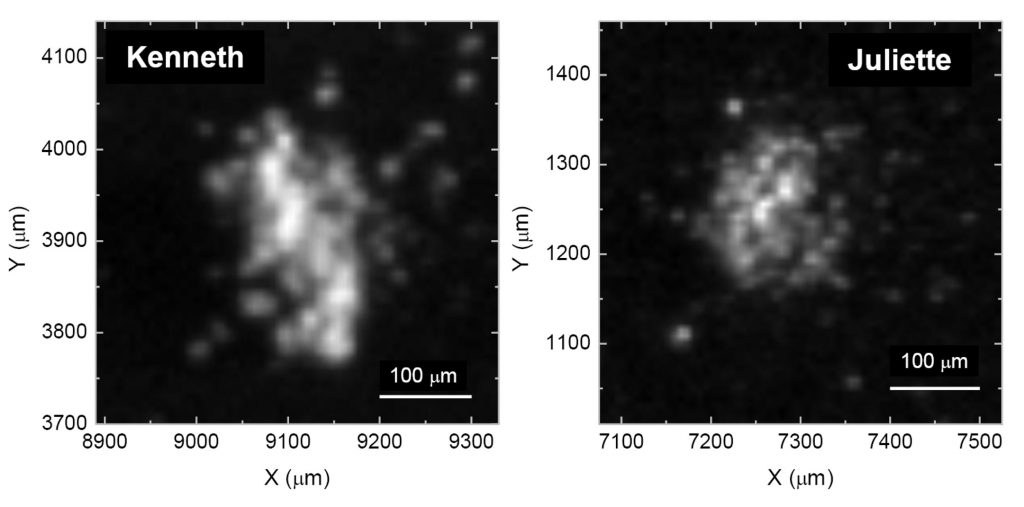
Optical image of two of the dust grains collected and analysed by COSIMA, named Kenneth and Juliette, which show the signature of carbon-based organics. They were collected in May and October 2015 respectively. Credits: ESA/Rosetta/MPS for COSIMA Team MPS/CSNSM/UNIBW/TUORLA/IWF/IAS/ESA/BUW/MPE/LPC2E/LCM/FMI/UTU/LISA/UOFC/vH&S/ Fray et al (2016)
“Our analysis reveals carbon in a far more complex form than expected,” remarked Hervé Cottin, one of the authors of the paper reporting the result that is published in Nature today. “It is so complex, we can’t give it a proper formula or a name!”
The organic signatures of seven particles are presented in the paper, which the COSIMA team say are representative of the two hundred plus grains analysed so far.
The carbon is found to be mixed with other previously reported elements such as sodium, magnesium, aluminium, silicon, calcium and iron. It is bound in very large macromolecular compounds similar to the insoluble organic matter found in carbonaceous chondrite meteorites that have fallen to Earth, but with a major difference: there is much more hydrogen found in the comet’s samples than in meteorites.
But as this kind of meteorite is associated with reasonably well-processed parent bodies such as asteroids, it is reasonable to assume that they lost their hydrogen due to heating. By contrast, comets must have avoided such significant heating to retain their hydrogen, and therefore must contain more primitive material.
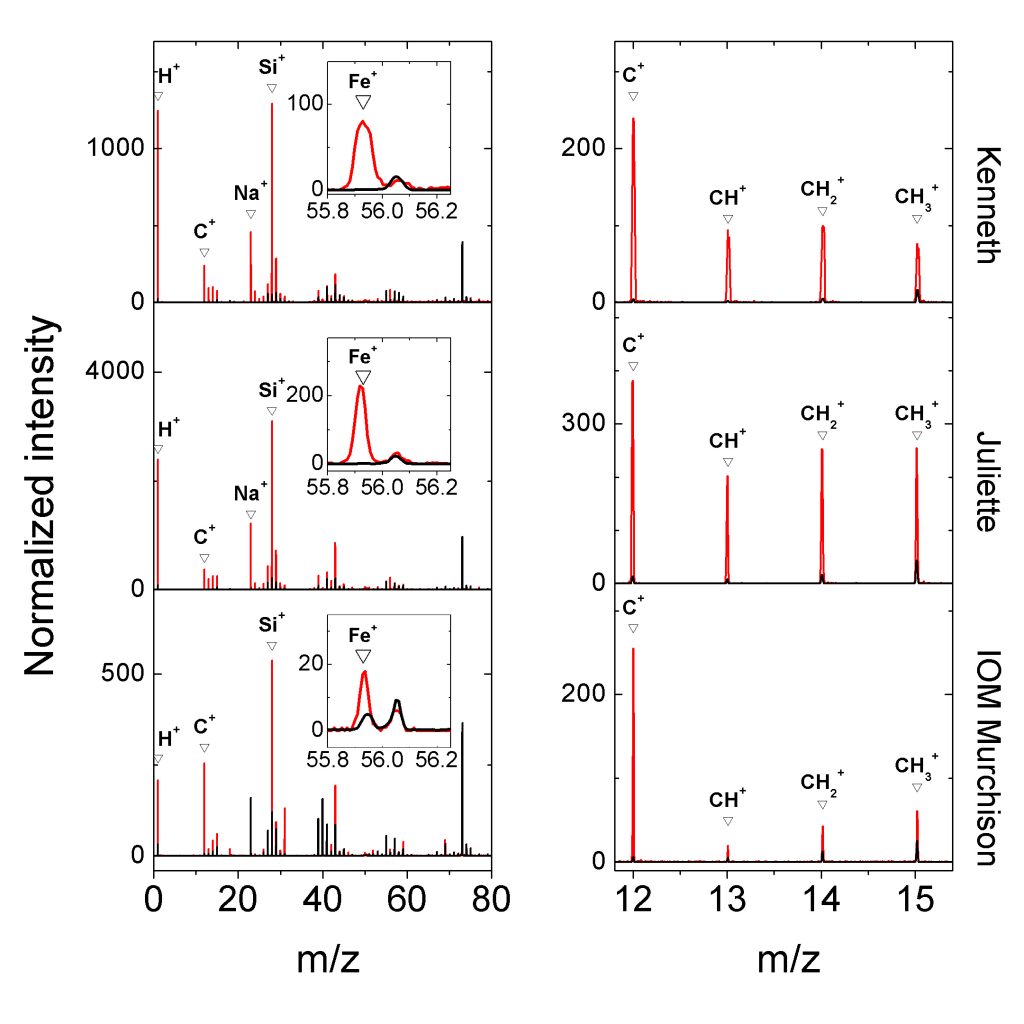
Comparing the spectra determined by COSIMA for the dust particles Kenneth and Juliette with the composition of organic matter (Insoluble Organic Matter, IOM) in the Murchison chondritic meteorite. The detections of hydrogen (H), Sodium (Na), Silicon (Si) and Iron (Fe) are also indicated. The red spectra are measured on the cometary particles while the black ones are measured next to them, and are representative of the instrument itself. Credits: ESA/Rosetta/MPS for COSIMA Team MPS/CSNSM/UNIBW/TUORLA/IWF/IAS/ESA/BUW/MPE/LPC2E/LCM/FMI/UTU/LISA/UOFC/vH&S/ Fray et al (2016)
From analyses of meteorites and laboratory simulations, the team was also expecting to identify a wide diversity of organic material in Comet 67P/C-G, ranging from very small molecules to heavy (or ‘high molecular weight’) organics.
Although Rosetta’s ROSINA and Philae’s PTOLEMY and COSAC instruments detected numerous low-molecular weight volatile organic molecules, COSIMA only saw very large carbon-bearing macromolecules in the dust particles, with nothing in between. This suggests potentially different sources for the lightweight volatile and heavier refractory carbonaceous material detected in the comet.
“Although we cannot know if the organics seen in these dust particles were created in the interstellar medium before the protoplanetary nebula came together, or in the protoplanetary disk during early Solar System formation, COSIMA’s dust grains are certainly witnesses to early formation processes, including that of the comet itself,” says Nicolas Fray, first author of the paper.
“These particles have remained pristine and untouched for billions of years until they were released in the days or weeks before being ‘caught’ by COSIMA,” adds Martin Hilchenbach, principal investigator of COSIMA. “The results add to the growing picture that Comet 67P/C-G contains some of the most primitive material from our Solar System’s early history.”
Quelle: ESA
-
Update: 9.09.2016
.
PRESSEEINLADUNG ZU ROSETTAS GROSSEM FINALE
Die Rosetta-Mission wird am 30. September mit dem kontrollierten Abstieg der Sonde zur Oberfläche ihres Kometen enden.
Medienvertreter sind eingeladen, den historischen Abschluss dieser Mission am 29. und 30. September gemeinsam mit den Rosetta-Wissenschafts- und Missionskontrollexperten im Europäischen Raumflugkontrollzentrum (ESOC) der ESA in Darmstadt mitzuverfolgen.
Rosetta wurde am 2. März 2004 gestartet und erreichte den Kometen 67P/Tschurjumow-Gerassimenko nach einer zehnjährigen Reise durch das Sonnensystem am 6. August 2014. Das Landegerät Philae wurde am 12. November 2014 auf der Oberfläche des Kometen abgesetzt.
Nachdem die Sonde den Kometen zwei Jahre lang auf Schritt und Tritt begleitet und bei dessen Annäherung an die Sonne eine beispiellose Flut an wissenschaftlichen Daten bereitgestellt hat, entfernen Rosetta und ihr Komet sich nun wieder über die Umlaufbahn des Jupiter hinaus von der Sonne.
Da sich Rosetta nun weiter von der Sonne wegbewegt als jemals zuvor und damit erheblich weniger für ihren Betrieb erforderliche Solarenergie zur Verfügung hat, ist das Schicksal der Sonde besiegelt: sie wird Philae auf die Oberfläche des Kometen folgen.
Die Bestätigung des Missionsabschlusses wird im Hauptkontrollraum der ESA am 30. September für 13.20 Uhr MESZ +/- 20 Minuten erwartet; die Sonde wird bereits am Vorabend auf Kollisionskurs mit dem Kometen geschickt.
In den letzten Stunden ihres Abstiegs wird Rosetta zahlreiche einmalige Messungen durchführen können, darunter die Untersuchung von Gas und Staub in nie dagewesener Nähe zur Oberfläche sowie hochauflösende Aufnahmen des Kometenkerns einschließlich der offenen Gruben in der Ma’at-Region, wo voraussichtlich der kontrollierte Aufprall des Raumfahrzeugs stattfinden wird.
Diese Daten dürften bis zum endgültigen Aufprall übertragen werden, danach wird eine Kommunikation mit der Sonde nicht länger möglich sein.
-
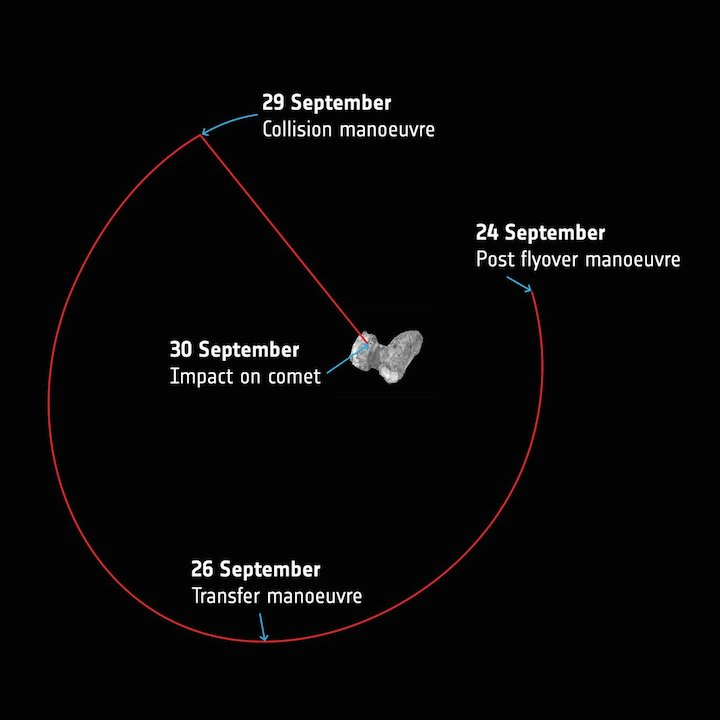
Die Medienvertreter sind eingeladen, am 30. September ab 10.00 Uhr MESZ die letzten Betriebsstunden der Mission im ESOC mitzuverfolgen und gemeinsam mit dem Missionsteam den Erfolg dieses sagenhaften Abenteuers zu feiern.
Wissenschaftsjournalisten können sich zudem für den 29. September zu einer Nachmittagsveranstaltung mit Rosetta-Wissenschaftsexperten anmelden, bei der die bisherigen wissenschaftlichen Höhepunkte der Mission erläutert werden.
Sowohl die Nachmittagsveranstaltung am 29. September als auch der Abschluss der Mission am 30. September können unter www.esa.int über Live-Streaming verfolgt werden.
Programm im ESOC
(alle Zeitangaben in MESZ, Änderungen vorbehalten)
29. September
Live-Streaming der Rosetta-Wissenschaftsveranstaltung von 14.30 bis 17.00 Uhr unter www.esa.int.
Rosetta hat den Wissenschaftlern zahlreiche Hinweise für die Klärung wichtiger Fragen zu Ursprung und Entwicklung des Kometen, seiner Stellung im frühen Sonnensystem und dem möglichen Beitrag von Kometen zur Entstehung von Leben auf der Erde, darunter Wasser und organisches Material, geliefert.
Die Rosetta-Wissenschaftler werden auf einer umfassenden wissenschaftlichen Entdeckungsreise die verschiedenen Puzzleteile zusammensetzen. Zunächst werden die vielseitige Oberfläche des Kometen, sein Innenleben und der von seinem Kern abgegebene Staub erläutert, bevor die Veränderungen in seiner Aktivität im Laufe der Mission und die Interaktion mit seiner Umgebung bei seiner Umrundung der Sonne unter die Lupe genommen werden. Des Weiteren werden die entdeckten organischen Moleküle und die Auswirkungen der gewonnenen Erkenntnisse auf unser Verständnis der Entwicklung unseres Sonnensystems veranschaulicht.
30. September
11.00–15.00 Uhr (Einlass ab 10.00 Uhr)
Das Medienprogramm umfasst die betrieblichen Höhepunkte des Abstiegs von Rosetta, der per Videostreaming live vom Hauptkontrollraum in das Medienzentrum übertragen wird. Missionsexperten werden die bisherigen wissenschaftlichen Höhepunkte der Mission erläutern und während der Annäherung Rosettas an die Kometenoberfläche die letzten Aufnahmen der Sonde präsentieren.
Die Mitglieder des umfangreichen internationalen Rosetta-Teams, darunter Wissenschaftler, Satellitenbetriebspersonal, Ingenieure, Vertreter der ESA, ihrer Partneragenturen und der Industrie sowie einige Ehrengäste, werden die letzten Stunden dieser Kultmission gemeinsam erleben und feiern.
Alle Anwesenden stehen für Interviews zur Verfügung.
Anmeldung
Medienvertreter mit gültigem Presseausweis und/oder einer Akkreditierung für soziale Medien werden gebeten, sich für die Veranstaltung am 30. September unter https://myconvento.com/public/event_register/index/1438240 anzumelden. Journalisten mit besonderem wissenschaftlichem Interesse werden gebeten, sich zudem für die Veranstaltung am 29. September anzumelden, die Plätze hierfür sind jedoch begrenzt.
Online-Informationen
Die Veranstaltungen am 29. und 30. September können unter www.esa.int live im Internet verfolgt werden.
Über die betrieblichen Meilensteine der letzten Missionstage wird zudem live über den Rosetta-Blog (blogs.esa.int/rosetta/), über @ESA_Rosetta (twitter.com/ESA_Rosetta ) und auf Twitter über @esaoperations (twitter.com/esaoperations) berichtet (Hashtag #CometLanding).
Hangout on Air – 19. September
Zur Vorbereitung des Missionsabschlusses wird am 19. September um 14.00 Uhr MESZ ein Hangout on Air veranstaltet, um die letzten Tage und Stunden der Rosetta-Mission vorzustellen und zu erörtern. Präsentiert werden der Abstiegsverlauf, die zu empfangenden Aufnahmen und wissenschaftlichen Daten sowie eine Zusammenfassung der Suche nach Philae, die am 5. September zur Entdeckung des Landegeräts auf dem Kometen 67P/Tschurjumow-Gerassimenko führte.
Quelle: ESA
-
Update: 10.09.2016
.
ROSETTA’S DESCENT TOWARDS REGION OF ACTIVE PITS
Squeezing out unique scientific observations until the very end, Rosetta’s thrilling mission will culminate with a descent on 30 September towards a region of active pits on the comet’s ‘head’.
The region, known as Ma’at, lies on the smaller of the two lobes of Comet 67P/Churyumov–Gerasimenko. It is home to several active pits more than 100 m in diameter and 50–60 m in depth – where a number of the comet’s dust jets originate.
The walls of the pits also exhibit intriguing metre-sized lumpy structures called ‘goosebumps’, which scientists believe could be the signatures of early ‘cometesimals’ that assembled to create the comet in the early phases of Solar System formation.
Rosetta will get its closest look yet at these fascinating structures on 30 September: the spacecraft will target a point adjacent to a 130 m-wide, well-defined pit that the mission team has informally named Deir el-Medina, after a structure with a similar appearance in an ancient Egyptian town of the same name.
Like the archaeological artefacts found inside the Egyptian pit that tell historians about life in that town, the comet’s pit contains clues to the geological history of the region.
Rosetta will target a point very close to Deir el-Medina, within an ellipse about 700 x 500 m.
Since 9 August, Rosetta has been flying elliptical orbits that bring it progressively closer to the comet – on its closest flyby, it may come within 1 km of the surface, closer than ever before.
“Although we’ve been flying Rosetta around the comet for two years now, keeping it operating safely for the final weeks of the mission in the unpredictable environment of this comet and so far from the Sun and Earth, will be our biggest challenge yet,” says Sylvain Lodiot, ESA’s spacecraft operations manager.
“We are already feeling the difference in gravitational pull of the comet as we fly closer and closer: it is increasing the spacecraft’s orbital period, which has to be corrected by small manoeuvres. But this is why we have these flyovers, stepping down in small increments to be robust against these issues when we make the final approach.”
The final flyover will be complete on 24 September. Then a short series of manoeuvres needed to line Rosetta up with the target impact site will be executed over the following days as it transfers from flying elliptical orbits around the comet onto a trajectory that will eventually take it to the comet’s surface on 30 September.
Quelle: ESA

